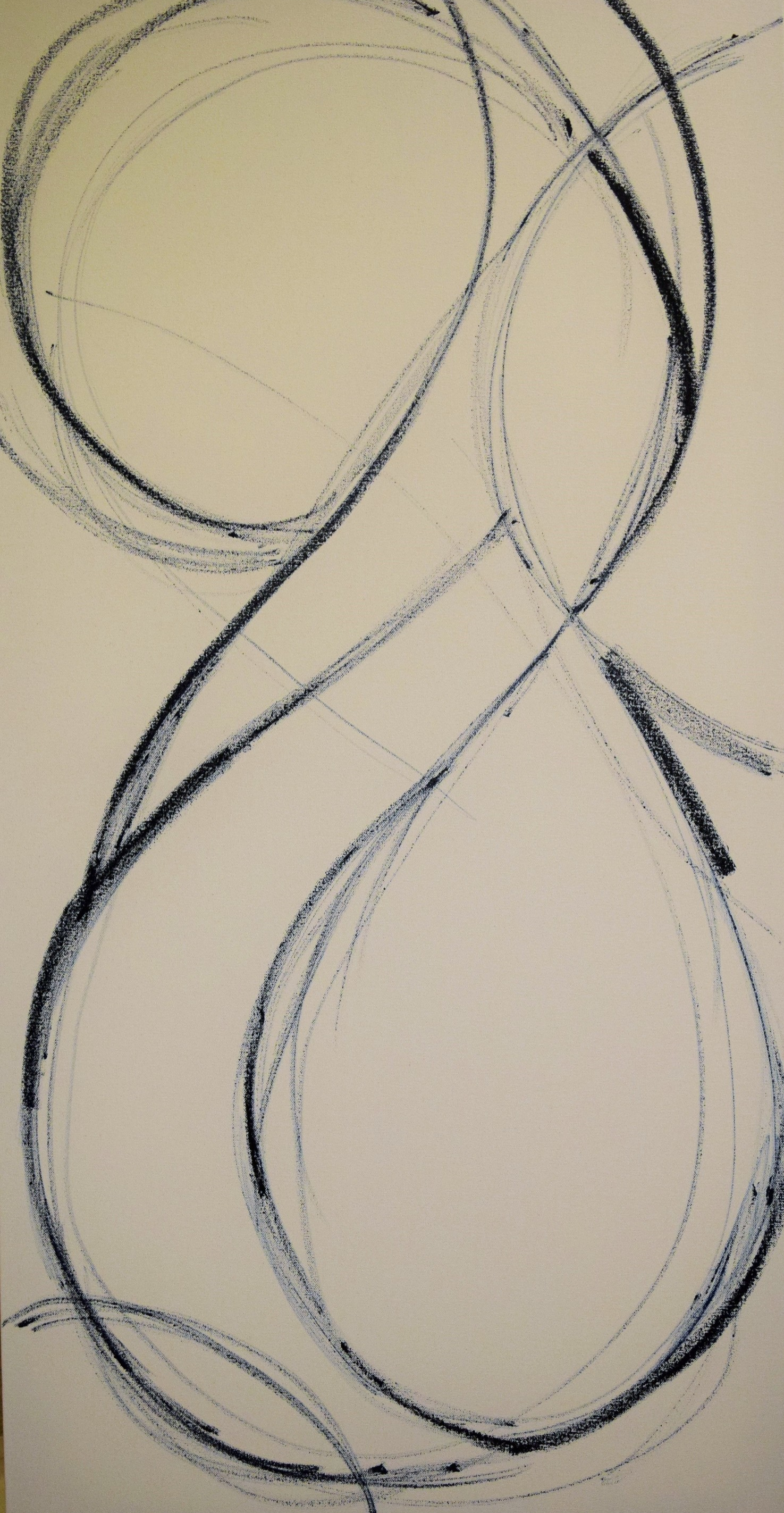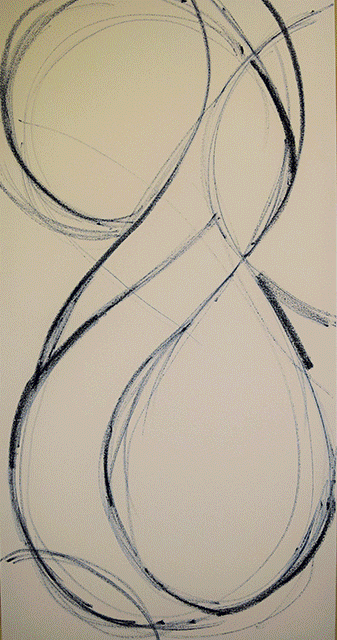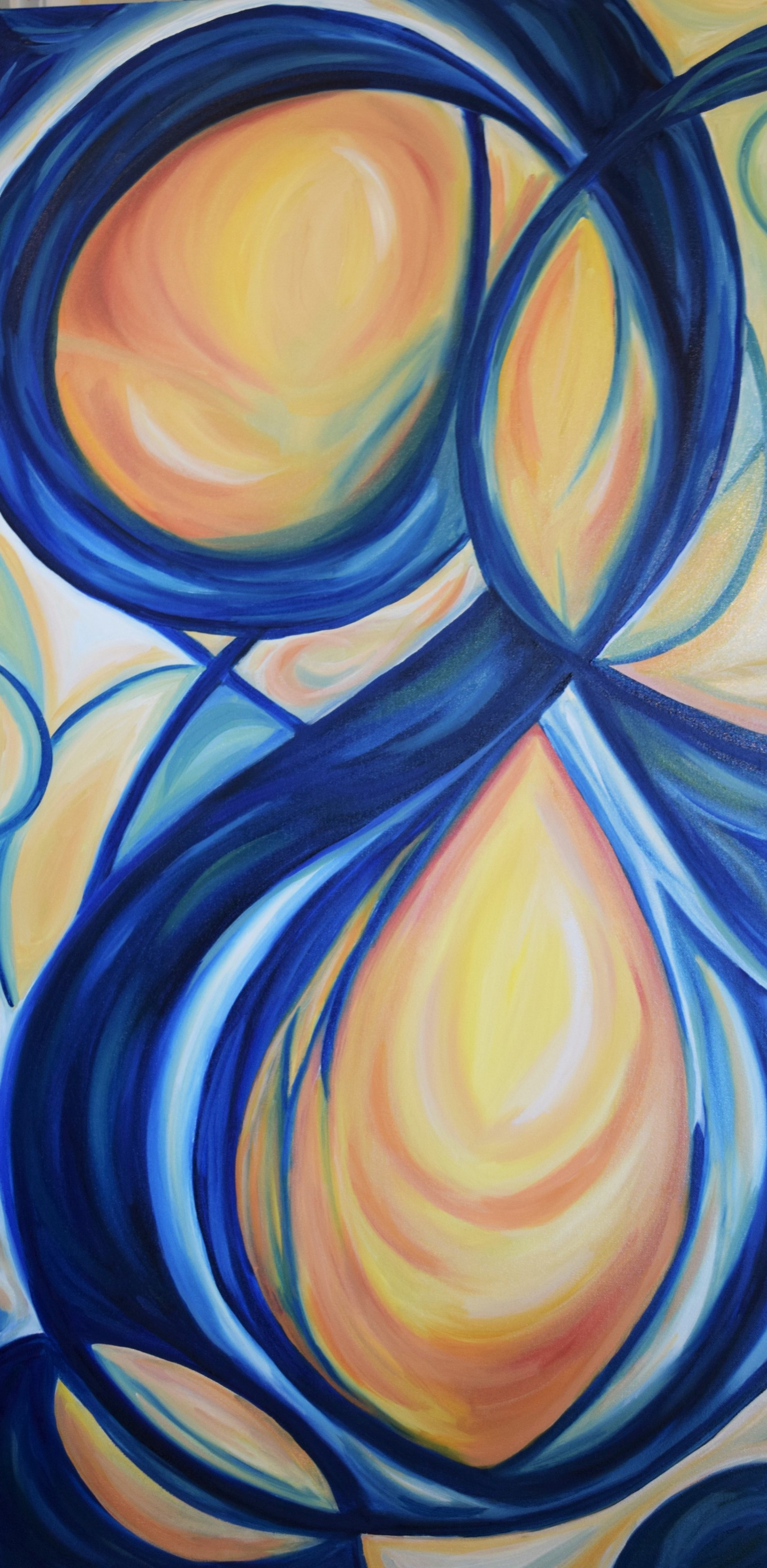Figure 1: Sketch. Oil stick on canvas.
As I set out to write about my latest painting, I discovered it is really hard to put my creative process into words without sounding like a pretentious asshole or alternatively, a valley girl, “Oh. My. God. I, like, totally love this painting. It was, like, the most amazing experience in the whole world to paint it. For sure.” So, I’m going to try not to sound like a valley girl and keep words like “amazing” to a minimum. I’ll also work on not sounding like a pompous ass. But I make no promises.
At this point, I think the painting is done, but I'm not sure, I’ll give it another day, time to dry, maybe touch up just one or two of those lines, probably ruin a different line, I’ll have to let it dry again and touch that up, which leads to...oh dear...this could go on indefinitely. I could be working on this painting for the rest of my natural born life, then I’ll die, come back and haunt the painting, at first it will scare the new owners but soon they'll be yelling, “Just leave it alone already!”
Done, or almost done, or never done, painting my first abstract oil in 14 years felt like a return to where I creatively belong.
I didn't always like or understand oils, my love for them had to evolve. Being used to paints like acrylic, watercolor, tempera, or any other reasonably-behaving, time-respecting, water based paint, oils took some getting used to.
My intro to them was in a high school art class, I was 16 and lacked the most important tool you need for oils: patience. Our first assignment was to paint a still life in sepia tones. Now let me say, for the record, while this may be some classic rite of passage as a student of art, this assignment totally sucks. And yes, that is my sixteen year old talking. Having to paint three pieces of fruit on a draped white cloth, on an 8x10 canvas with three tubes of oil based paint, that wouldn’t dry today, tomorrow, the next day, was just plain mean. Unlike my militant watercolor teacher the semester before who would have held our hands as we painted if he could’ve, the oil teacher was much more free form. With the briefest of introductions we were thrust into the assignment.
I thought the assignment was stupid, what was the point in painting fruit in monochrome? I charged ahead to get it done and move on to the next thing. Very quickly I had too much paint on the canvas and the more I tried to add detail to the fruit the more detail disappeared. I became incensed and tried harder which led to more blending, soon I was staring at a sea of sepia with little to no distinction of any kind.
I was used to Acrylic. Acrylic is very forgiving. “You painted a line you don’t like? Forgetaboutit, you give me an hour and you paint right over it. You hear me?” I’m not really sure why acrylic paint sounds like it is from New Jersey in my head…no wait…yes, I do…because acrylic has your back. It’s going to work with you to get the job done, quickly. Oil is more like Yoda, “PATIENCE YOU MUST HAVE. Try not. Do, or do not. There is no try.” Oil requires you to slow down. Be thoughtful. Wait. Plan. Be a Jedi. All things that were hard at 16.
Figure 2: Painting on left is the first oil I did at college. Unfortunately, I don't have a full view of it.
By 20, things had changed, I had changed. Making art was no longer about what was left once I had finished, it was also about the process. I was taking a class in mixed media and when we moved into the curriculum around oils I was resistant. My professor gave me oil sticks, they were like giant Craypas, and said to have fun. "Have fun!", I scoffed. I was fully prepared to hate every minute of it but for some reason I decided to go big or go home. I stapled a 5 foot by 7 foot canvas up on the wall, prepped it, and late one night, alone in the studio, I put on my Walkman, listened to Aretha Franklin’s “I Never Loved a Man (The Way That I Love You)” on repeat and wildly sketched my first real oil painting. At first the sketch was a chaotic mess of swirls but then I saw them: the women trapped in the painting, and I began to feverishly paint to free them from obscurity. I used paint thinner to bleed the color out of the oil stick sketch which created an ink like feel.
Soon I was staring at the framework of my painting, it was very clear in my mind even if it was still a mess on the canvas. I felt excited about my art in a way I had never felt before.
With such a large canvas there was always plenty to work on while other parts dried. I got to play and really learn to blend oil paint on the canvas. I got to explore the differences in translucency using paint thinner and linseed oil. I got to really understand it. And suddenly I wanted to do it all the time. But I had to follow some basic rules:
Respect the laws of chemistry: As my dad has been reminding me this week when I was desperate to mess with my new painting, oil doesn't dry, it cures. There is no way around that. With water based paints you can speed the process using a fan or a hairdryer, with oil, you wait. And wait. And wait. And…you get the picture.
Be intentional: For areas that I know what I want represented, I put down color thoughtfully because it is not easy to fix quickly. But if it's abstract and I have the liberty to, I also leave areas for play.
Leave it alone: This is really an extension of the first rule but it is the hardest rule. It is so hard to walk away from a painting knowing exactly what you want to do but not being able to because it is wet. Truth be told, I’m terrible at this rule and I frequently go back too soon which leads to more waiting.
With these rules in mind, I set off to work on my first oil painting in over a decade.
THE PLAN:
- 24x48 canvas
- Oil paint
- Sketch with an oil stick just like the old days
- Music
- Paint whatever comes up
HOW IT WENT:
Figure 3: Painting coming to life.
I always listen to music while I paint. Even before The Mannequin Room, it has been intertwined with my process. My paintings end up with their own soundtrack, songs that seem to choose themselves for the project. For this painting, it was Thelonious Monk’s ‘Round Midnight purely by the grace of the random shuffle gods. Random, but perfect. With that song as the backdrop, silenced thoughts and the vast possibilities of a quiet mind, I was in love with this painting from the second or third line I drew. The first few nights I worked on it, I was absolutely lost in the painting. Breathlessly enjoying the vibrancy of colors. It was not that I thought what I was making was a great masterpiece, it was that it spoke to me so personally. There were moments where I was near tears for reasons I can’t quite explain. Maybe it was that I was allowing myself this experience at all that choked me up. It was something just for me which felt rather indulgent for a mother of three spending the time painting (during naps or after bedtime) when there are always chores to be done.
Also, I had forgotten what a visceral experience oils can be. It activates all senses. Deep smells, impossible richness of color, the sounds, the sensations. The brush dragging across the bumps on the canvas causing tiny vibrations to echo up the arm and through the whole body. The paint’s lushness, thick, gliding, blending with the canvas, melting away to create something unique on that one spot on earth. How did I get this color to do this? When it is working, it feels like magic.
And then the hard part begins, trying to finish it. I knew what I wanted but only because I had already painted things I saw weren’t working. So I had to wait until the paint dried enough to make changes. In some cases, I had to wait days. I wasn’t good at that and several times tried too soon and made things worse before they got better. And then there was at least a week of trying to tidy things up.
WHAT I LEARNED:
Figure 4: Final (maybe) Painting
When I began to fill color in I had a moment where I thought, “Oh, people will say, it’s one of those paintings again.” But quickly a new voice argued, “You mean, one of MY paintings? Yes, this is going to look like one of my paintings.” There is an old voice in my mind that wants me to create things that it thinks are acceptable. It says, “Sure, paint an abstract painting but can’t it be of a fish? That’ll make sense because you just painted that aquarium painting, that was fun, wasn’t it?” But that voice is being challenged through this project and is losing power.
The emotions and the intense need for freedom as I started this painting were overwhelming and when I allowed myself to do whatever I wanted, it was such a relief. But the old voice continued to wrestle me, “What is this going to be a painting of?” It asked impatiently.
“Of the heart,” the new voice tried to offer “A love affair between these colors. The types of blues that choke me with emotion, colors that I could live in forever.”
"That's absurd, it won't mean anything to anyone but you." The old voice grumbled.
"So be it." A voice down deep replied.
I’m still working on my attachment to whether or not what I create is liked. Does it matter? If no one likes it but me, will I keep doing it? Given the joy it brought me to do? I hope so.



